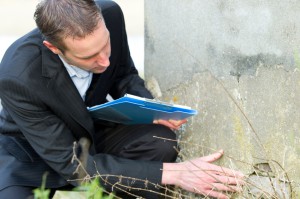When it comes to buying a home or an investment property, it is vital that you conduct a thorough inspection before you sign on the dotted line – to ensure you don’t buy a lemon. 
Just because a property looks good on the outside, it could have serious defects that may not be immediately obvious and they may end up costing you thousands of dollars to repair.
Yesterday in Part 1, we went over the first two of the 10 key problem areas identified to look out for before you buy property:
- Water Damage
- Uneven Floors, Walls and Ceilings
Today this article will focus problem areas three and four:
- Foundation Problems
- Plumbing Issues
3. Foundation Problems
Simply put, the weight of a property is transferred to the land it is built on, be it rock or soil.
If this land shrinks or expands, it could cause the property’s foundation to move.
Checking for foundation problems is very important, because if there are issues – it could be very costly to repair.
Soil tends to expand when it’s wet and shrink when it’s dry.
This swelling and shrinking is what can cause property foundation movement to occur, which in turn can lead to serious and expensive structural problems.
Examples of the causes of these problems include poor water drainage (which keeps soil moist near the property) or the planting of trees and plants around the property’s perimeter (which can cause soil to dry out).
There are a number of signs that may indicate foundation problems, which you should look out for:
- Cracks in walls and ceilings, and even window panes

- Doors and windows that jam and won’t open/close properly
- Uneven and sloping floors
- Spaces or gaps opening up in the joins between walls and ceilings
- Cracked and displaced wall and ceiling mouldings
- Sloping and cracked chimneys
- Walls leaning or separating from the house frame
- Cracks and gaps in exterior brickwork
- If you have any doubts in the property you are inspecting, you should arrange for a structural engineer’s report before you buy. Apart from identifying major problems, the report can be used as a tool in order to help negotiate the price down to cover the cost of any remedial work.
4. Plumbing Issues
We all know from experience that plumbing problems can be expensive to fix, not to mention being a possible major inconvenience, so it is important to keep an eye out for plumbing issues during your inspection.
Being able to identify potential problems, especially major ones, as early as possible and certainly before you buy is ideal.
Here are some things to look out for while conducting your inspection:
Hot Water Service 
- Check the adequacy of the hot water service. Find out how old it is, whether it will be able to supply enough hot water for your needs and when it was last serviced.
A hot water system can be expensive to repair and even more expensive to replace if it is old or faulty.
Make sure you get the evidence you need – such as testing the temperature by running hot water taps in different rooms and sight the original purchase and service invoices – to get assurance of its age, maintenance history and that everything works as it should.
Drainage
- Make sure drains are working properly (to ensure there are no clogged pipes) and flush each toilet to check there is adequate water flow.
Trees 
- Examine the position of the trees on the property to help determine if there may be any potential or actual root damage to sewer pipes.
You’ll need a map of the easements and sewer lines to identify if there’s a possible problem.In the worst case, tree roots can crack and grow through sewer pipes causing major problems including blockages. Again, this can be costly to repair, especially if you have to unclog or replace any broken pipes.
It can also be messy if the sewerage backs up and overflows into the property.
All Plumbing 
- It is also a good idea to check the age and general state of repair of all the plumbing works in the bathroom, kitchen and laundry (i.e. basins, taps, sinks, showers and baths).
Ideally, it would be great if these items were aesthetically pleasing but more importantly they need to be functional and in good working order.
Remember, having to redo or remodel a bathroom or kitchen can cost thousands of dollars.
If you’re in any doubt about the quality or the functioning of a property’s plumbing, seek advice and assistance from an independent plumber.
In my next column we’ll take a look at how to identify possible problems with driveways and paving, renovation restrictions and limitations, and a property’s history.
Editors Note: This article has been republished for the benefit of our many new readers
Related articles:


No comments:
Post a Comment